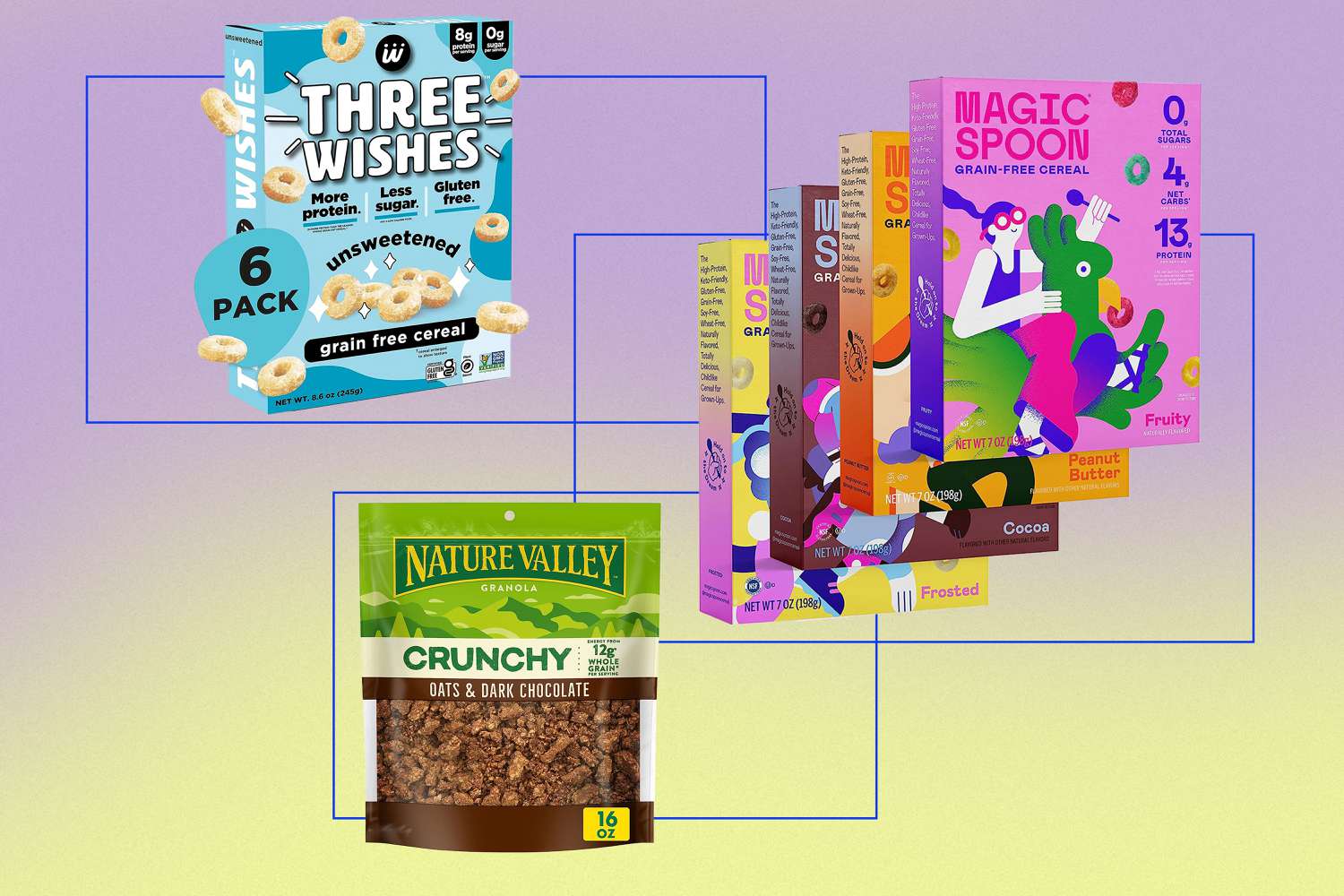Dietitians Reveal the Top High-Protein Cereal Options

Jump to a Section
There are few things more nostalgic than a bowl of cereal. For many folks, the dish sparks thoughts of cartoon mascots, '90s commercials, and rushing to school in the a.m. (Ah, the memories!) And while a lot of the cereals of your childhood probably still exist, you might be looking for something higher in protein to eat on the regular, especially if you have muscle-building goals.
Enter: high-protein cereals. Traditional cereals are typically low in protein, so by making the swap, you'll be able to take better advantage of the benefits of protein at breakfast. As registered dietitian Maddie Pasquariello, M.S., R.D.N., explains, “Adding protein to the first meal of your day will keep you more satiated and [energized] throughout the morning.” (This can be especially helpful if you plan to work out after breakfast or often feel ravenous by lunchtime.) “Some high-protein cereals [might also be] higher in fiber, lower in sugar, and/or made with more natural flavors and colors compared to their traditional cereal counterparts,” adds Pasquariello.
But with so many options on the market, you might be unsure which products to try. With the help of expert dietitians, we did the research to find the best high-protein cereals on grocery store shelves based on different goals and preferences.
'Catalina Crunch is [a] high-protein cereal that comes in a ton of different flavors, including Cinnamon Toast, Dark Chocolate, Fruity, Maple Waffles, and more,' says Pasquariello. 'This one is super hearty and flavorful, with a rich, graham-cracker-like texture and major crunch factor.' One half-cup serving contains a whopping 11 grams of protein due to the brand's 'Catalina flour' blend, which contains pea protein, says Pasquariello.
Flavors: 6 | Protein per serving: 11 grams | Dietary Needs: Vegan, gluten-free
With a price tag on par with traditional cereals, Special K's Protein Cereal is one of the most affordable options on the list. It also has an impressive 15 grams of protein per 1 1/3 serving, which comes from soy protein isolate. It's one of the best-tasting protein cereals as well, notes Victoria Whittington, R.D.N., registered dietitian at Atlas Optimization, who says this product is her favorite protein cereal.
Flavors: 1 | Protein per serving: 15 grams | Dietary needs: Kosher
For a grown-up, high-protein version of your favorite childhood cereals, Magic Spoon might be just what you need. The brand offers nostalgic flavors such as Fruity, Frosted, Cocoa, and Peanut Butter, points out Pasquariello, who is a fan of the product. Each flavor contains 13 to 14 grams of protein, zero grams of added sugar, and natural ingredients such as turmeric and spirulina for color. But take note: All of Magic Spoon's cereals contain a milk protein blend, so you'll have to pass if you follow a dairy-free diet.
Flavors: 4 | Protein per serving: 13 to 14 grams | Dietary needs: Gluten-free
If you prefer granola with milk to cereal, this one's for you. 'This product is packed with protein, [with] 13 grams per 2/3 cup serving thanks to soy protein,' says registered dietitian Roxana Ehsani, M.S., R.D., C.S.S.D., L.D.N. 'It also contains heart-healthy oats, four grams of dietary fiber, and heart-healthy fats,' she adds. Not to mention, it has dark chocolate, which is always a plus.
Flavors: 1 | Protein per serving: 13 grams | Dietary needs: N/A
Like Ezekiel bread, this product contains sprouted grains and legumes, including wheat, millet, lentils, soybeans, and spelt. 'It doesn't contain any type of protein powder, but thanks to the sprouted grains and legumes, it [is] a high-protein cereal,' says Ehsani. One half-cup serving offers eight grams of protein. However, at $14 per box, it's also one of the pricier options on the market.
Flavors: 4 | Protein per serving: 8 grams | Dietary needs: Vegan, organic, kosher
'[This] Three Wishes cereal is unique because it contains just four ingredients,' notes Ehsani. This includes chickpeas along with pea protein, tapioca, and salt. (The flavored versions contain a few more ingredients, such as monk fruit.) The product, which is vegan and gluten-free, clocks in eight grams of protein per 3/4-cup serving. It's also 'super crunchy, with a not-too-sweet, oat-y flavor that reminds me of a nostalgic childhood cereal,' shares Pasquariello.
Flavors: 7 | Protein per serving: 8 grams | Dietary needs: Vegan, gluten-free, kosher
At 20 grams of protein per one cup serving, 'this option is high in protein and it's got a great crunch,' according to Whittington. The protein comes from a combo of soy protein isolate and wheat protein isolate. It's also plant-based, available in Chocolate Almond and Mixed Berry Almond, and works well as a breakfast cereal or high-protein snack, adds Whittington.
Flavors: 2 | Protein per serving: 20 grams | Dietary needs: N/A
'Not only is this cereal high in protein, but it's high in fiber, which makes it super filling,' shares Whittington. Depending on the flavor, each 3/4 cup serving offers nine to 14 grams of protein from soy protein isolate and six to nine grams of fiber. Also, this cereal isn't super sweet, making it ideal if you prefer an earthy granola taste, notes Whittington.
Flavors: 7 | Protein per serving: 9 to 14 grams | Dietary needs: Vegan (certain flavors)
To find the best high-protein cereals, we asked three registered dietitians — Victoria Whittington, R.D.N., Maddie Pasquariello, M.S., R.D.N., and Roxana Ehsani, M.S., R.D., C.S.S.D., L.D.N. — for their personal recommendations. For each product, we asked the experts to call out their favorite features, such as noteworthy ingredients, protein content, or flavor options. With this info, we scoured the cereals’ product listings and ingredient labels, then compared them to each other and traditional cereals on the market. This allowed us to pick category winners based on different dietary needs, taste preferences, and price points.
Starting your day with a high-protein cereal — and high-protein foods in general — has myriad benefits. For starters, protein is a vital macronutrient, meaning your body needs it in large amounts to support basic functions (think building tissue and repairing cells), according to the book, Biochemistry, Nutrients. Adding high-protein cereal to your rotation can help you get a jump-start on your protein intake first thing in the morning, points out Whittington.
Consuming protein in the morning may help you meet certain health goals or needs. For example, if you're doing tough workouts, recovering from illness or surgery, or following a vegan or vegetarian diet and struggling to get enough protein, a high-protein cereal can help increase your protein intake, says Pasquariello. Additionally, if you have diabetes, eating a high-protein cereal can help prevent blood sugar spikes due to the combo of protein and carbs, says Whittington.
'On a chemical level, adding protein, fiber, and/or a source of fat to your meal can enhance glycemic control — essentially helping your system digest sugar more slowly, and preventing blood sugar from spiking after the meal,' explains Pasquariello. 'For most traditional cereals, there's more sugar and less protein, fat, and fiber — so the chemical effect would be to spike your blood sugar a bit more.' That said, occasionally consuming traditional cereals won't present an issue unless you have prediabetes, diabetes, or another chronic condition that requires managing your blood sugar, she stresses.
Protein also keeps you full for longer compared to carbs alone, as protein is gradually digested by the body. Thus, starting your morning with high-protein cereal can help stave off hunger, making the food a lifesaver on busy days. On the flip side, traditional cereals are usually low in protein, so they likely won't keep you feeling full for long, says Ehsani. (Though, you can also pair regular cereal with a protein-rich food, like yogurt or eggs, for a more balanced meal, if that's your jam.) With that in mind, if you're looking for a quick meal that will keep you full between breakfast and lunch, a protein-packed cereal might be just what you need.
As with most foods, not all high-protein cereals are equal. They also typically cost more than their traditional counterparts, so several factors are worth considering before you pick up a box.
First thing first: 'Just because a cereal says it's high in protein doesn't give it a health halo,' notes Ehsani. It can still contain unhealthy (think saturated and/or trans) fats or added sugars, which you might want or need to avoid. With that in mind, it's important to check the label to ensure it aligns with your nutritional preferences.
The source of protein can also vary. For example, a high-protein cereal might get its protein from whey protein isolate, soy protein, or pea protein, according to Ehsani. If you follow a dairy-free or vegan diet, you'll want to pick a plant-based option, notes Whittington. Some cereals might also include high-protein ingredients such as nuts, seeds, lentils, or legumes, according to Ehsani.
The amount of protein per serving can vary widely too. In general, high-protein cereals may offer between eight to 20 grams per serving, according to Whittington. (For context, the protein in traditional cereal is typically two to four grams of protein per cup, according to Pasquariello.) When shopping for high-protein cereals, Pasquariello usually looks for options with about 10 grams of protein and five grams of sugar (or less) per serving, but these numbers will differ depending on your goals and taste preferences, she notes. For more personalized recommendations, chat with a doctor or dietitian.
Finally, like standard versions, high-protein cereals can be sweetened with sugar or artificial sweeteners or have no sweeteners at all, says Pasquariello. Generally speaking, options sweetened with added sugar typically have cane sugar, just like traditional cereals, she notes. 'You may also see stevia extract and/or monk fruit extract added to unsweetened high-protein cereals to make them more palatable,' adds Pasquariello. Options with milk protein may also taste sweeter, as the ingredient is naturally sweet.
All that said, if flavor is an important factor for you, 'keep in mind that a fully unsweetened option may need some dressing up to make [it] taste closer to the original cereals you're used to,' says Pasquariello. This might call for flavored nut milk, some fresh fruit, or a drizzle of honey, she notes. Again, check the label to get an idea of the ingredients and flavors you can expect from the product.
Kirsten Nunez is a contributor at Shape who has covered health, nutrition, and food for nearly a decade. Her educational background includes an M.S. in Nutrition and B.S. in Dietetics. For this article, she consulted registered dietitians to get their expert recommendations for high-protein cereals and the benefits of eating more protein. Kirsten also spent hours researching the experts’ top picks to hone in on the pros, cons, and most important features of each high-protein cereal.




